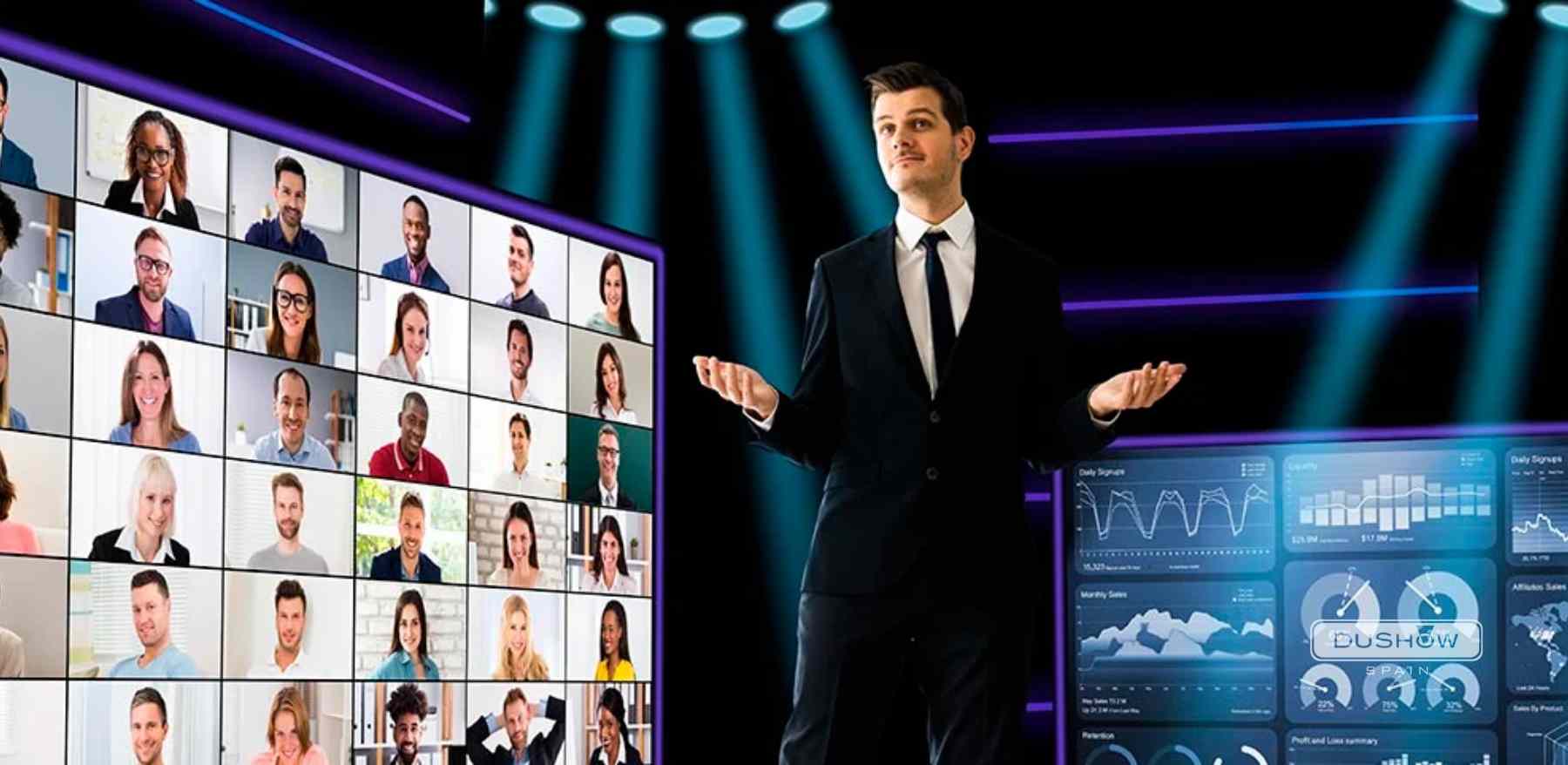Dushow Spain is now Novelty Spain
Event technology: Virtual Stages and Augmented Reality
It doesn't matter whether you're planning a new product presentation, organizing a congress, or a shareholders' meeting. Event technology is a key ally when it comes to achieving one of the most important goals of event organization:
catching the attention of your attendees.
If you don't fine-tune your message to have an impact, and remain etched in the audience's memory, no matter how much you have planned your event, or broken sponsorship records... Will your event be sentenced to oblivion? Possibly, yes.
In this post, we will introduce two of the most useful tools to ensure that your events will be remembered by your audience: virtual stages and augmented reality.
Event technology: What is a Virtual Stage?
Let's begin with a few definitions within the event technology realm. A Virtual Stage is a stage set up for an event using digital tools, which will be viewed when the virtual event is streamed or broadcast.
Generally, it is done by using a physical set with a green background (Chromakey), where a person speaks or gives a presentation, while any type of digitally-created scene or setting is filled in around them.
You've already seen this technique thousands of times in films, where a Chromakey background works as a canvas on which digital technicians can display whatever is necessary.
But be careful! It's not just a matter of putting up a nice-looking background (like Zoom now lets us do). A virtual stage enables you to hold a virtual event while generating a hyper-realistic setting to present to your audience. This empowers you to generate greater engagement, even while communicating through a screen.
Benefits of the Virtual Stage
In addition to enhancing dynamics and catching the attention of your attendees, using event technology like Virtual Stages will bring even more benefits to your event, such as:
- Enhance the engagement with your audience by making your presentations in hybrid or virtual events that much more innovative and attractive. It can be a powerful resource for corporate events.
- Switch stages instantly For example, if the speaker has to move from rain forest to desert in the blink of an eye, you can do so without any difficulty. This enables us to convey feelings and sensations that have to do with different places, while making brand storytelling that much easier.
- Overcome the physical separation between speakers who may be in different parts of the world. People can interact on a virtual stage, which simulates a physical space in a single setting.
Event technology: What is Augmented Reality?
Using augmented reality (AR) as a virtual reality event technology is a matter of adding digitally-created visual layers to what is already visible in the “real world”.
With augmented reality, there can be interaction between real objects (such as a speaker on an actual stage) and realistically-presented digital components. These real-life objects can be placed anywhere on the stage, and around spectators.
“Pokemon Go" and Instagram filters that add visual layers to a real image are the most current examples of how this event technology is used. However, this resource has been in use for much longer, for example, in televised football matches (when the crests of the teams appear on screen) or weather forecasts.
The only limit to this event technology's application at events is your imagination. You can let your attendees see the inner workings of an engine at the presentation of a new vehicle, unveil a surprise gift, or have a fictitious character as the master of ceremonies.
Advantages of Augmented Reality
Augmented reality is a great way to fight the fatigue often felt by remote audiences. Here are a few of its benefits:
- Greater interactivity between the audience and AR objects. The use of 3D objects to communicate ideas makes for an experience your audience is sure to remember.
- More dynamic content. Monotony is the leading cause of attention deficit at events, and this event technology is a great way to break it.
- Using artwork aligned with the design of your event or brand. You now have the chance to create content that will be remembered as a unique characteristic and intrinsic part of your brand.
- Defining hierarchies of importance among the material presented A clear way to highlight the information or device that the audience's attention should be focused on is to augment it or make it interactive through augmented reality.
Why do we recommend our clients use this event technology?
Planning and producing events in the present time requires companies to make a huge effort. Offering solutions and new ways to communicate before changing scenarios will enable you to make the difference as a company. What's more, adding technological tools to your events makes you much more versatile.
Attendees' attention (especially in cases of streamed events) is a prized commodity, and one that's getting harder to come by.
That is why we recommend our clients use virtual stages, augmented reality and other event technologies to stand out. Efficiently communicating your company's message in an on-line environment is not easy, but if you do it correctly and distinctly, you can get a fantastic return on the investment made.
This article was first published in Dushow Spain, you can read the original Spanish version here.





